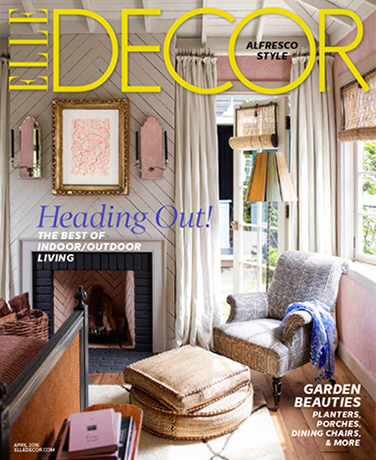ELLE DECOR
In renovating their riad in Marrakech, two New York designers find that the vagaries of the local building traditions are nothing compared with the challenge of merging their two very distinct visions
By Gisela Williams
When Martin Raffone and William McIntosh, successful interior designers from New York, began the process of renovating a riad they had purchased in the medina of Marrakech, they did what they would normally do for any of their clients: They spent several months meticulously preparing professional construction documents. "That was a big mistake," McIntosh says with a laugh. "I doubt anyone ever looked at them once."
Five years after finally completing the house, a narrow, two-story building with a rooftop terrace, a small central courtyard, and an attached studio apartment, the couple can make fun of their learning curve. "We understood pretty quickly that it does not work in Marrakech the way it works in Manhattan," says Raffone. "It's a much more organic process. The craftsmen in Morocco interpret, misinterpret, and bring their own vision of ancient craft to every detail of the project."
"In New York, the work we do is so fussy and technical," McIntosh adds. "In Morocco, you put up a wall and then decide where to put a hole in the wall to make a window."
To their initial dismay, in several cases the end result was radically different from their original design. For a guest bath, they had wanted the ceiling lined with sticks embedded in plaster, a traditional Moroccan technique; instead, when they returned from a trip, they found a ceiling of ribbed plaster. McIntosh was somewhat upset that instructions hadn't been followed, but Raffone loved it. "What an incredible misinterpretation," he says. "Their version was way better."
McIntosh eventually warmed to the unpredictability of working with Moroccan artisans. "Chance and circumstance can be great design partners," he says. He lists other happy surprises: "The bookshelves in the living room became floating slabs of concrete, and the rear stairwell became a wonderful modernist composition of interlocking forms."
On occasion it was actually trickier for the two professional designers to work together. They had never collaborated before and had different ideas for the house. "I was interested in the quality of the light and the experience of outdoor living," says Raffone, "and Bill had a vision of drinking a cocktail and reading by the fire." While both are rooted in modern design, Raffone says he leans toward "the rustic, warm camp" while McIntosh prefers "the refined, luxe version."
Having spent several months in the house before the renovation began, they could agree on what they wanted to preserve and what they wanted to change. It had been redone fairly recently, but "some of the doors wouldn't close, and rain would come into the bedroom," McIntosh explains. "Some rooms were uncomfortable and awkward."
In the end, they reworked almost everything. They altered the sizes of the windows and lowered the windowsills to let in more light, and they added a skylight in the attached apartment, which became two guest rooms. They installed a fireplace in the living room and completely redid the bathrooms and kitchen. It took a year of traveling back and forth between the daily reality of Manhattan and the visceral reality of the medina to finish the job. "New York will always be our home," Raffone says, "but what we miss when we are away from Marrakech is a sense of honest life. There's an energy to the streets that I don't feel any where else. People there have such strong relationships to each other. It's an authentic community."
The pair sourced artisans in the medina and beyond for the interiors. Almost all of the furniture was custom made. "The only things we actually purchased were the campaign chairs," says McIntosh. Raffone designed color-blocked poufs, some made of leather and others of awning canvas, the Z-shaped wood chairs, and the dining table. McIntosh designed the pendant lights and armoires made of wood and tadelakt, a plaster that is hand-polished with stones. And they painted much of the artwork themselves. "That's another reason why we love being in Marrakech," says McIntosh. "We find ourselves with the time and space to create. We had two or three weeks in the middle of the renovation where we set up rooms as studio spaces and made paintings and sculptures."
Raffone was so inspired by the process that, early this year, he opened a design shop in the Gueliz neighborhood that sells many of the pieces he created for their home, as well as a variety of objects sourced from their travels. "I actually prefer the design process here," concludes Raffone, who is now splitting his time equally between Marrakech and Manhattan, while McIntosh travels to Morocco every six weeks. He explains that the name of his boutique, maisonLAB, refers to the laboratory-like experience of creating things in Morocco. "You set out to solve a problem and, through trial and error and a bit of luck, you end up with a beautiful resolution."




